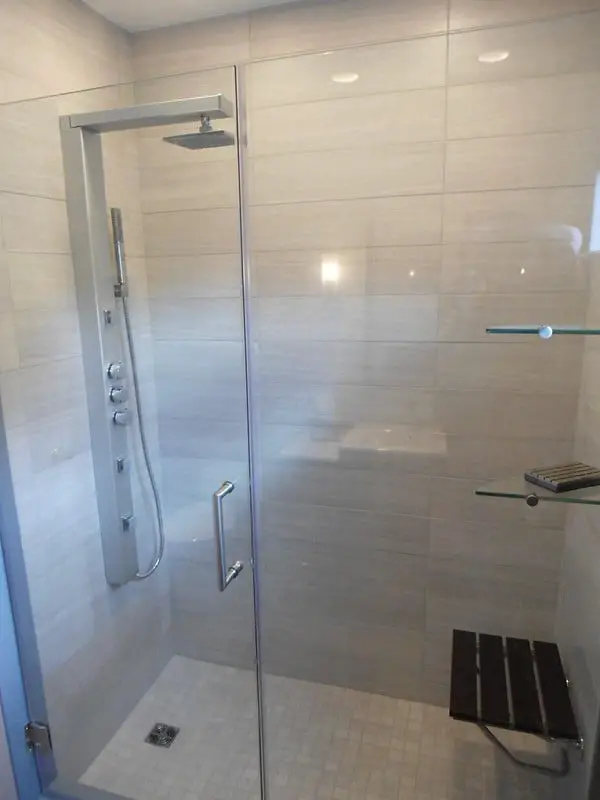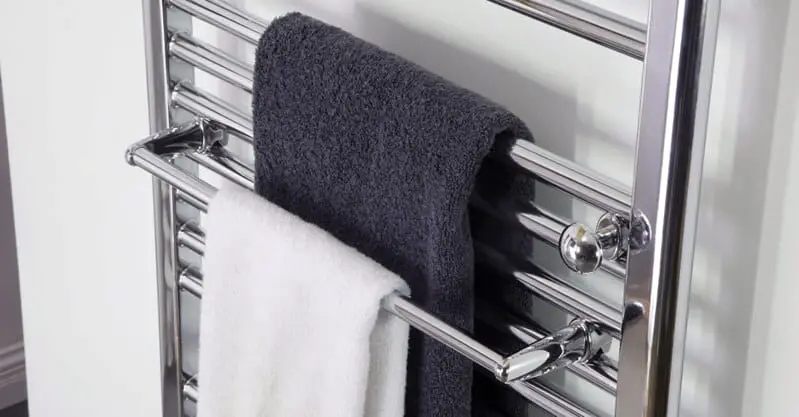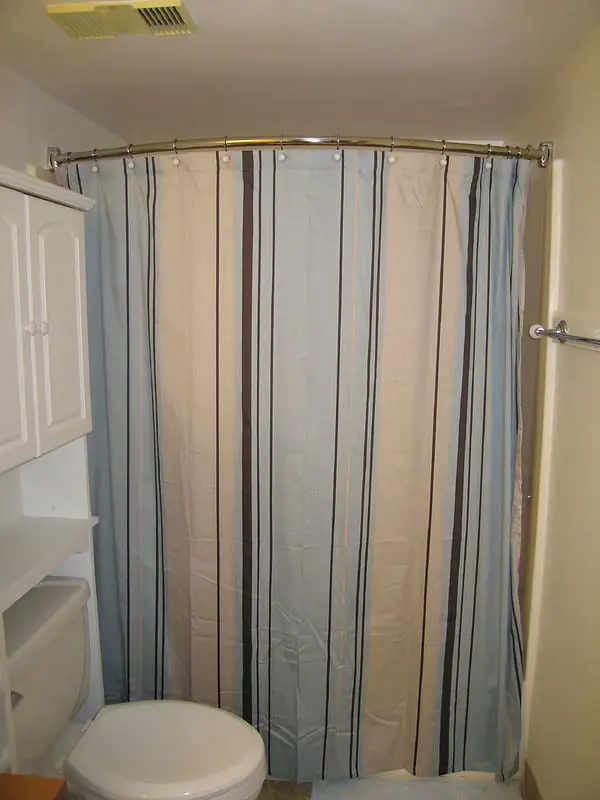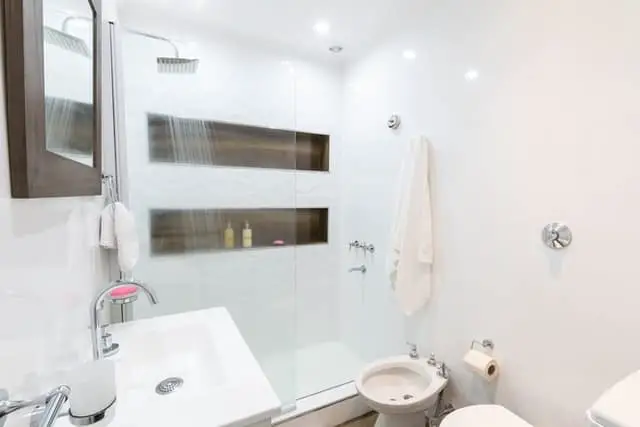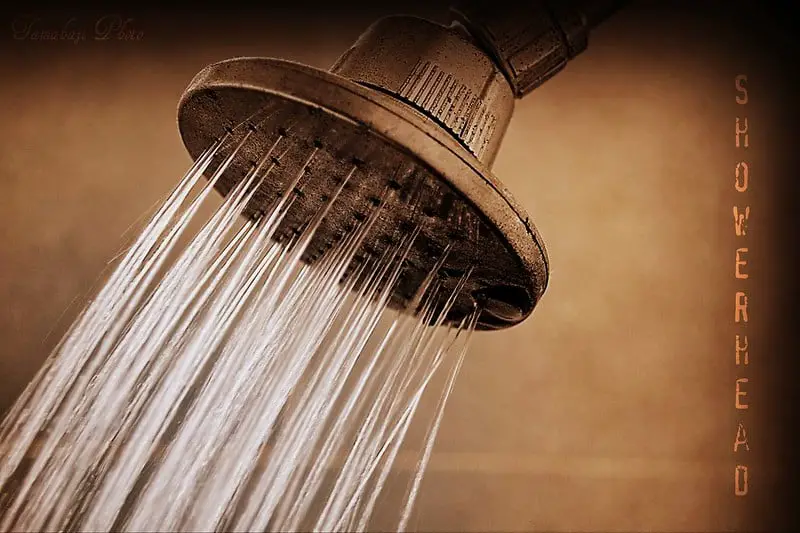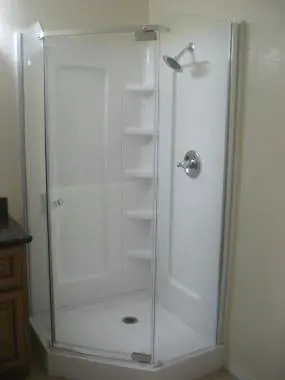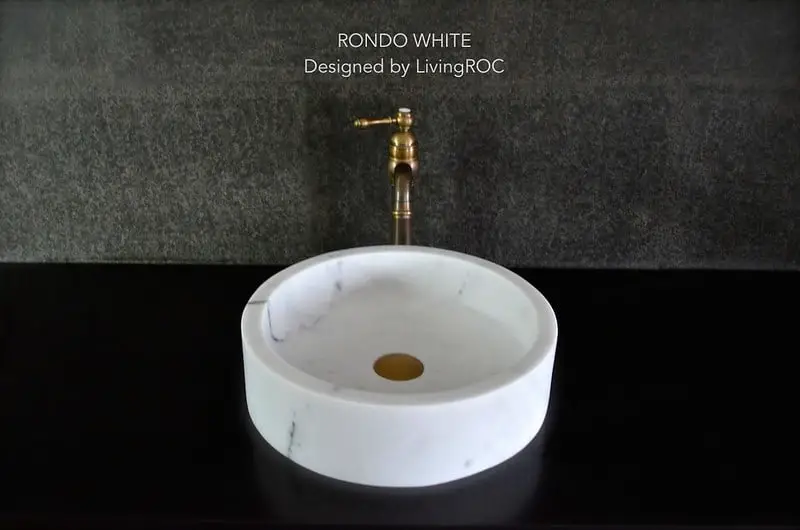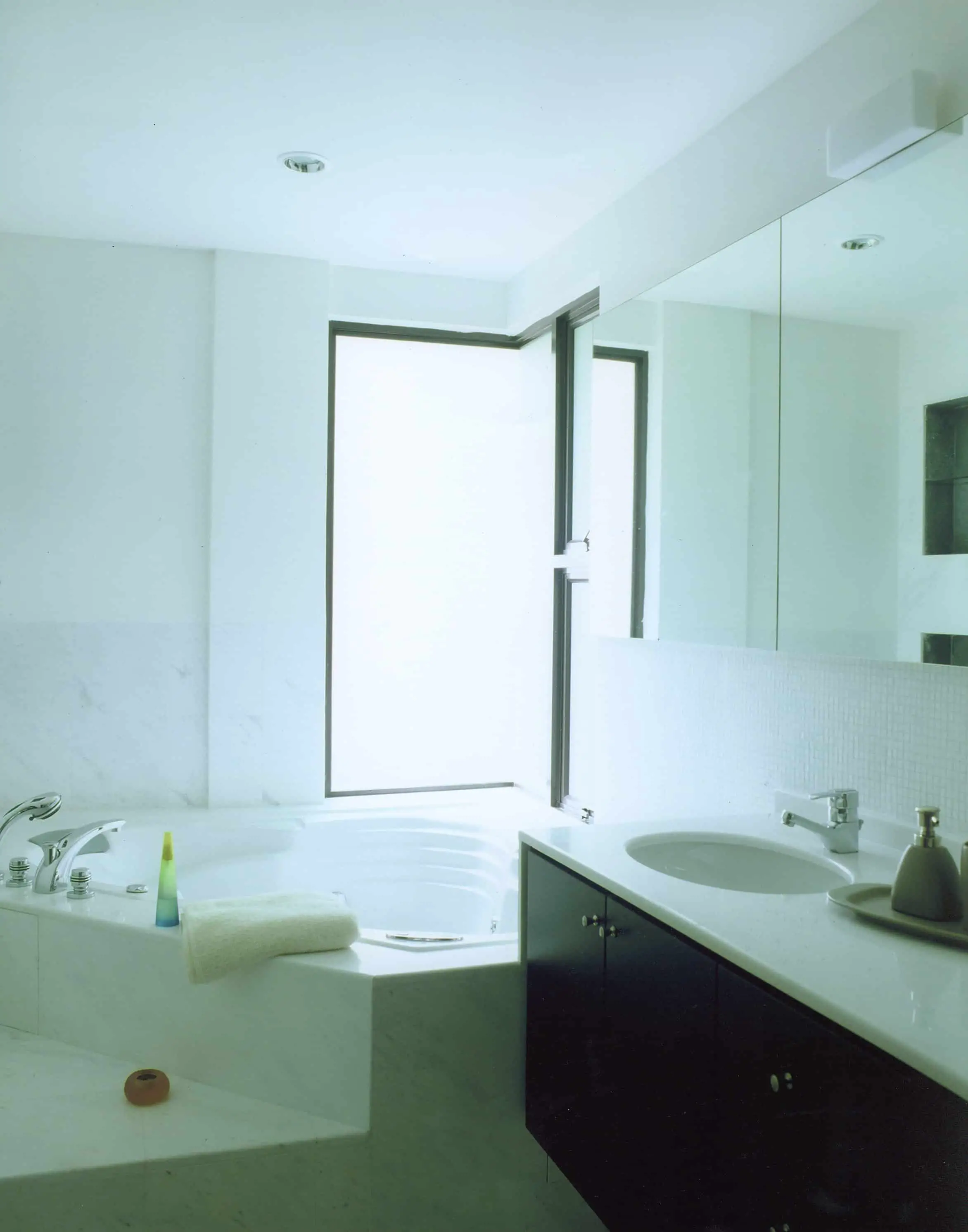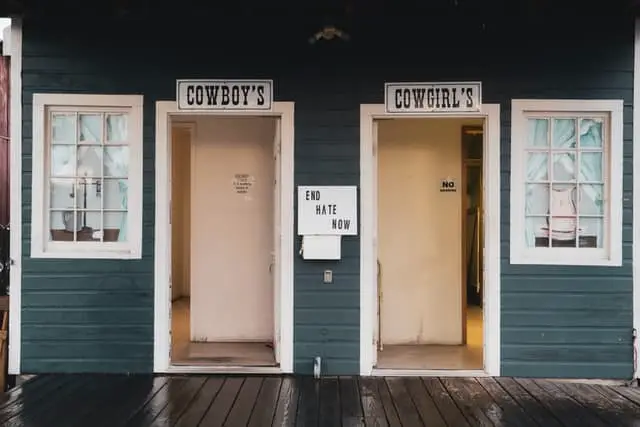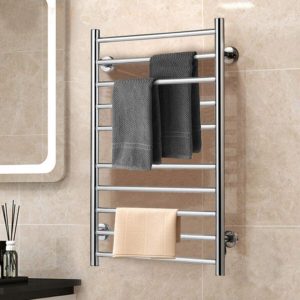
Stepping out of your bath or shower into a clean warm robe or towel is one of the little luxuries of life.
Not only do manufactured home towel warmers make this luxury a reality, but they are also great multi-functional additions to your space as part if a remodeling project.
They are perfect for a large family or roommates and add the much-needed warmth to the bathroom helping you to create a comfortable bathing space.
Space-saving and contemporary designs can also prove valuable in creating an eye-pleasing feature.
They can also be installed in cramped spaces, a feature that makes them perfect for small bathrooms.
Seven Manufactured Home Towel Warmer Pre-Shopping Questions
Before even making up your mind on what towel warmer to buy, ask yourself these important questions:
- What is the difference between hydronic and electric models?
- What type of warmer do you think will fit your budget? Example: designer or economical model?
- What are the perks that come with choosing a plug-in or hardwired installation?
- Should you go for a simple, sleek line or a more artistic and eccentric design?
- Which option do you think will suit your warming needs, freestanding or mounted?
- Should you choose a unit equipped with a time or one without?
- What type of finish do you think will complement your existing décor?
Seven Towel Warmer Shopping Factors
When shopping for a towel warmer, you want a model that meets your criteria and one that addresses your warming needs.
Remember to consider these seven factors:
- Type – Electric v/s Hydronic
- Source of Power
- Mounting & Installation Size & Style
- Price v/s Budget
- Size & Style
- Floor Standing v/s Wall Mounted
- Projection
1. Type – Electric v/s Hydronic
Virtually all the towel warmers you will find in the store can be split into two main types – electric and hydronic – all of which are energy efficient.
Electric Towel Warmers
Electric warmers are typically designed to consume power at a very low rate.
Most of the models you will find in the store consumes the same amount of power as your standard light bulb (about 60 Watts).
It is almost standard for electric models to contain one of the two popular types of small wattage heating elements:
- some of them utilizes a dry heating element
- while others are equipped with an element that heats mineral oil inside the unit.
Electric warmers are available in two groups –
- plug-in
- and hardwired.
Hardwired units need to be fully integrated into your home’s electrical system.
Plug-in models, on another hand, are plugged in the wall socket like any other electric home appliance.
Both types of warmers can be operated with a simple timer or an on/off switch.
Some of the largest electric units you will find can produce enough heat to keep the whole room warm as long as you want, although they are normally run in conjunction with a second source of heat for more effective heating.
Hydronic
Hydronic models utilize your home’s hot water plumbing system to produce heat simply by running a stream of hot water throughout the towel warmer.
This is normally done in two ways:
- Firstly, by linking to your household’s hot water system (or open system).
- The second method involves linking to a particular hydronic heating system (or closed system).
The hydronic warmer is certainly not the most energy-efficient towel warming option out there. Also, it is the hardest to install as it requires you to consider it during the construction stage of your home or the remodeling project.
Most of today’s towel warmers come with many safety features, such as automatic shut-off systems and thermostats, all of which help keep the risk of fires or overheating at bay.
2. Source of Power
There are three types of towel warmers based on the source of power –
- central heating warmers
- electric-only warmers
- dual fuel warmers.
Electric Towel Warmers


Electric towel warmers are designed for bathrooms found in homes where central heating is not a viable option. As the name suggests, they are plugged into the home’s power supply.
This type of warmer is easier to fit than any other type of towel warmer, but you might still need a professional electrician to install it.
They also represent the most preferable and cost-effective towel warming solution both to run and buy.
They feature modern elements of design. This makes them be some of the most aesthetically pleasing towel warmers available today
Electric options are the best warming solution if you’ve ruled out extending your pre existing water heating systems or worry about a line of moving pipework.
The best thing about electric towel warmers is that they work with your current mains electric system without the need for extensive wiring.
They are also double insulated to boost safety. Even better, most of them come already filled with much-needed water treatment to prevent the development of limescale and corrosion.
Just like plumbed radiators, they are mounted on the wall but should be only installed by qualified personnel.
Controls
Some of the electric towel radiators you will find in the store comes with more effective thermostatic controls instead of the conventional on/off controls.
These permit you to set specific radiator temperatures that meet your needs or opt for pre-set temperatures to which you would like the room to be heated.
The radiator will intelligently control its own heat output to keep your desired room temperatures by cycling on/off, helping to cut energy usage in the process.
Some premium options go further allowing the user to set time schedules, so that the device turns on at a specific time of the day, very much like your central heating system.
Electric warmers that are thermostatically controlled often come with anti-freeze functions intended to automatically turn on the device if the temperature drops low enough to a point of freezing the surface (usually around 7ºC) thus helping to prevent destruction from frozen pipes.
You will need to leave your radiator switched on – it will not generate any heat unless it gets very cold. It is ideal for users who like to leave home after a bath.
Dual Fuel Towel Warmer


Dual fuel warmers provide the best advantages of electric and plumbed appliances – basically, the best of both worlds (electric and central heating towel warmers).
Hence, it’s unsurprising that they are some of the most used towel warmers in all types of homes.
A typical dual fuel warmer comes with an incorporated electric heating element. The electric element is then linked to the central heating system, making the whole system a dual fuel warmer.
The towel warmer is equipped with a T-shaped accessory to isolate it from the rest of the plumbing system. This permits it to work as a distinct unit different from the normal heating system.
Both the two heating elements – the electric and the plumbed type – guarantee a constant energy supply, keeping the towels warm as long as you want. This is still the case during the summertime when the central heating is normally turned off.
Most models have their electric elements controlled with a thermostat and switch so you can easily turn it on/off to get extra warmth any time you need it – ideal for application during the hot summer.
It is recommended that you choose heating elements that are accompanied by a timer function so that the towel warmer can be set to run when the central heating system is not running.
Note that although dual fuel options ensure great flexibility, you will require both mains electricity supply and plumbing at the location you plan to install the dual towel warmer.
Central Heating Towel Warmers


Many American homes are regarded to fall in the ‘off the gas grid’ category. Still, central heating towel warming devices are a better option for roughly 50 percent of households serviced by a central heating system.
These towel warmers are normally plumbed into an existing central heating line with a few radiator valves, often two.
Your central heating powered towel rack will operate almost the same way the standard radiator would.
It is, however, important to bear in mind that your towel rack would emit a considerably lower heat output compared to the conventional radiator.
The easiest method to replace a towel rack or radiator is to choose a device with similar sizes and identical pipe centers
Turning off the central heating system will stop the flow of water to the towel warmer so you won’t need to remember to switch it on.
3. Mounting & Installation
Take some time and consider the wall or surface where you plan to mount the towel warmer.
If you are refitting or redecorating your bathroom, tile or paint behind the towel warmer before fitting it, as you will find this easier.
If you are going for plumbed towel warmers, consider the existing pipework. And if you are replacing your old radiator, start by measuring the space and the dimensions of your new towel warmer to minimize plumbing changes.
A narrower warmer may need more changes to your existing plumbing, especially if the pipes were installed to rise off the floor instead of running along the wall.
If you will be forced to make changes to your existing underfloor plumbing, keep in mind that you will be required to lift the floorboard. This means you will need to consult a plumber first before proceeding with the project
By far the most DIY-friendly and easiest options to install are the electric/plug-in models.
Most of the options you will find in the store use the standard 120V plug.
Better yet, they can be easily plugged into any compatible outlet very much like any other household appliance.
Another easier to install device would be the freestanding plug-in model which is portable and easily movable as needed.
While the installation process of any typical towel warmer is normally simple and straightforward, there are a few significant variables in electrical and plumbing configurations.
For that reason, the appropriate installation of both hydronic and hardwired electric warmers often need the skills and experience of a licensed plumber or electrician to maintain the warranty provided by the manufacturer, which will add on your initial expense.
4. Size & Style
There is the right towel warmer for every bathroom and every need!
The list of sizes and styles is quite extensive, typically ranging from classic to contemporary, traditional to artistic, and even models with antique styles.
Straight or curved rails?
Straight tops or arched?
Whatever your taste is, you should evaluate the options carefully in consideration of your needs and source of power before settling for one.
When selecting such an eye-arresting addition for your bathroom, what’s most important is to choose a model that goes with your personal style.
Perhaps the most important of this aspect is the finish:
- Although some manufacturers may opt to stick with the more common chrome or polished brass finishes, a big part of the warmers you will find in the store comes in a range of designer finishes such as oil-rubbed bronze, satin nickel, antique gold, and more.
- If you are adding your warmer to a room with existing fixtures, consider choosing one that will complement their finish and style.
- Some units can include a shelf for storage and/or extra heating, or a robe hook.
- While there are many choices and options available, consider your own personal use of the warmer: some features may really not be necessary.
- Eliminating unnecessary features may also save you some money.
5. Price v/s Budget
Today’s market avails a wide range of price tags. Whether you are seeking an absolute design sophistication or a moderately priced model, you are guaranteed to land a decent towel warmer for your budget.
The price tags on towel warmers can vary considerably depending on the size, installation, and even style – just to list the most obvious variable factors.
As mentioned earlier, there are multiple ways to install your towel warmer, but each of which may influence the potential budget considerations as you will need to hire a licensed professional to work on it.
The cost of acquisition is another factor worth considering. Most of the popular brands in the market offer several lines of towel warmers.
Budget-friendly lines seldom surpass the $300 mark. The most impressive and high-end lines, some with designer finishes, can cost anything up to $4,000.
Start by preparing a well-thought budget. Perusing through the available options with a budget ready in your mind can be the first step to selecting a towel warmer suitable for your needs.
6. Floor Standing v/s Wall Mounted


There are two types of towel warmers based on the area of installation –
- floor-standing
- wall-mounted.
Your choice between these two types will depend on the free space available in your bathroom.
Floor standing products are ideal where there’s enough floor space to accommodate it.
For small bathrooms, a wall-mounted towel warmer would be perfect.
If you are opting for the wall-hung type, ensure the fixings used to hold it are appropriate for your wall and that, your property being a manufactured house, the drywall itself can support the load as required.
If you are uncertain, it is recommended that you hire a qualified professional to do all the installation work.
7. Projection
Just like the device’s height and width, you should consider the projection of the towel warmer.
This helps ensure it doesn’t end obstruct anything already in the bathroom.
Remember, that the load (or towels) placed on the radiator can add a further 20 – 40 mm to the projection, although this can depend on thickness.
Related: Bathroom Hardware Guide
Summary
Just as you would with any other home appliance, you need to be choosy when shopping for a towel warmer, more so if you want to land to buy the best product for your needs.
To do so, you need to bear in mind a few factors at play.
Almost all the towel warmers you will find in the store can be split into two main types – electric and hydronic.
The former can be plugged in the wall socket or linked to your household electricity line while the latter draws some water from your home’s plumbing to assist in towel warming.
When it comes to the source of power, however, you will be split between three types of towel warmers – electric, central heating system, and dual fuel models.
There is the right towel warmer for every bathroom and every need, you just need to be a bit careful with the style and size of the model.
Pricewise, today’s market avails a wide range of price tags. Whether you are seeking an absolute design sophistication or a moderately priced model, you are guaranteed to land a decent towel warmer for your budget.
The price tags on towel warmers can vary considerably depending on the size, installation, and even style.
The size of your bathroom will determine whether you are going for a floor or wall-mounted model. And
Just like the device’s height and width, you should consider the projection of the towel warmer. This helps ensure it doesn’t end obstruct anything already in the bathroom.

